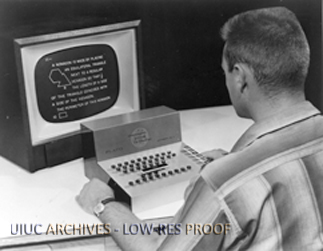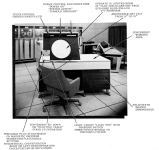There aren't any other 'graphics cards' that came before the Dazzler right? I'm saying graphics as opposed to video card.. Im assuming the VDM-1 takes the ribbon there.
To be serious again for a moment, a sideline here that might deserve mention is the Polymorphic VTI card; it came out around January 1976, which makes it a few months later than both the Dazzler and the VDM-1, but it might have been the first cheap memory-mapped card that combined both alphanumeric display and a semi-useful graphics resolution into a single unit. (Its resolution of 128x48 is the same number of dots as the GT-6144's 96x64.)
The GT-6144 is actually kind of an interesting animal to mention since it's *not* a memory mapped graphics card, it's an external device accessed over a parallel port. Conceptually I guess it's roughly analogous to later port-accessed graphics boards like the Matrox ALT-256/ALT-512.
Just to be clear here, are you trying to pinpoint the invention of "graphics" displays, or memory mapped displays, or just "the first one hooked to a microprocessor", or what? Graphics displays using vector/oscilloscope technology go back to the very dawn of electronic computing (late 1940's), and memory mapped raster-scan displays were a fairly common (if expensive) thing by the early 1960's on interactive mainframe/minicomputer applications. (See:
NLS, home of the "The Mother Of All Demos" and
PLATO terminals for just a couple examples.) Nobody
invented anything here in applying these techniques to microprocessor driven computers.
That reminds me - I've read in some places that Woz did produce some kind of TV Typewriterish terminal prior to the Cream Soda computer, possibly around the same time or shortly after Don Lancaster's. One source, which I cannot find now, claims it was actually produced. Never seen a pic of one though. Supposedly this was borrowed from for the Apple-1.
You didn't take this seriously, did you? People say really stupid things on the Internet.
Anyway, around the time Don Lancaster was building the TVT-1 Woz was working at Hewlett Packard. HP had been making computers for years and while their first
home-grown terminal didn't go on sale until 1974 it was doubtless under development at the time and HP was selling rebranded Datapoint and Beehive terminals that I'm sure young Mr. Wozniak got to play with and learn about at work. And yes, at some point prior to joining the Homebrew Computer Club in early 1975 he'd apparently already built his own. What's the point? He didn't
invent anything, terminals based on semiconductor shift register memory like the TVT-1 and what Woz glued to a 650x CPU in early 1976 had been a commercial product
since 1967. (There are earlier units like the
IBM 2260 from 1964 that used acoustic delay lines.) That he built a copy of a thing he saw at work to have at home is, well, good for him, it's nice that he was in the privileged position to do such a thing.
Anyway, this whole deal with the "Cream Soda Computer" feels like another item that needs to be seriously debunked. That dingus he built in 1971 was made out of
a couple Intel bitslice ALU chips and some SRAM chips his dad got him from work. These ALU chips had been around for a few years and were becoming standard building blocks for making minicomputers and small mainframes. Said chips would have been on the expensive and exotic side for mere mortals to lay hands on in 1971, but by the end of the 1970's building a rudimentary computer out of them was pretty much a standard part of a college computer engineer course. In all of these interviews Woz dredges up this thing as evidence that he's some kind of revolutionary super-genius doing stuff nobody ever thought of before, but... I dunno, a really jaded person might just congratulate him for being able to read a manual.
Suffice it to say the "Cream Soda Computer" is a considerably less impressive achievement than the Kenbak-1 in my book, because the latter is actually built from small-scale TTL logic, not, uhm, actual "computer chips". But yeah, Woz, yours had a lower chip count, we heard you.




